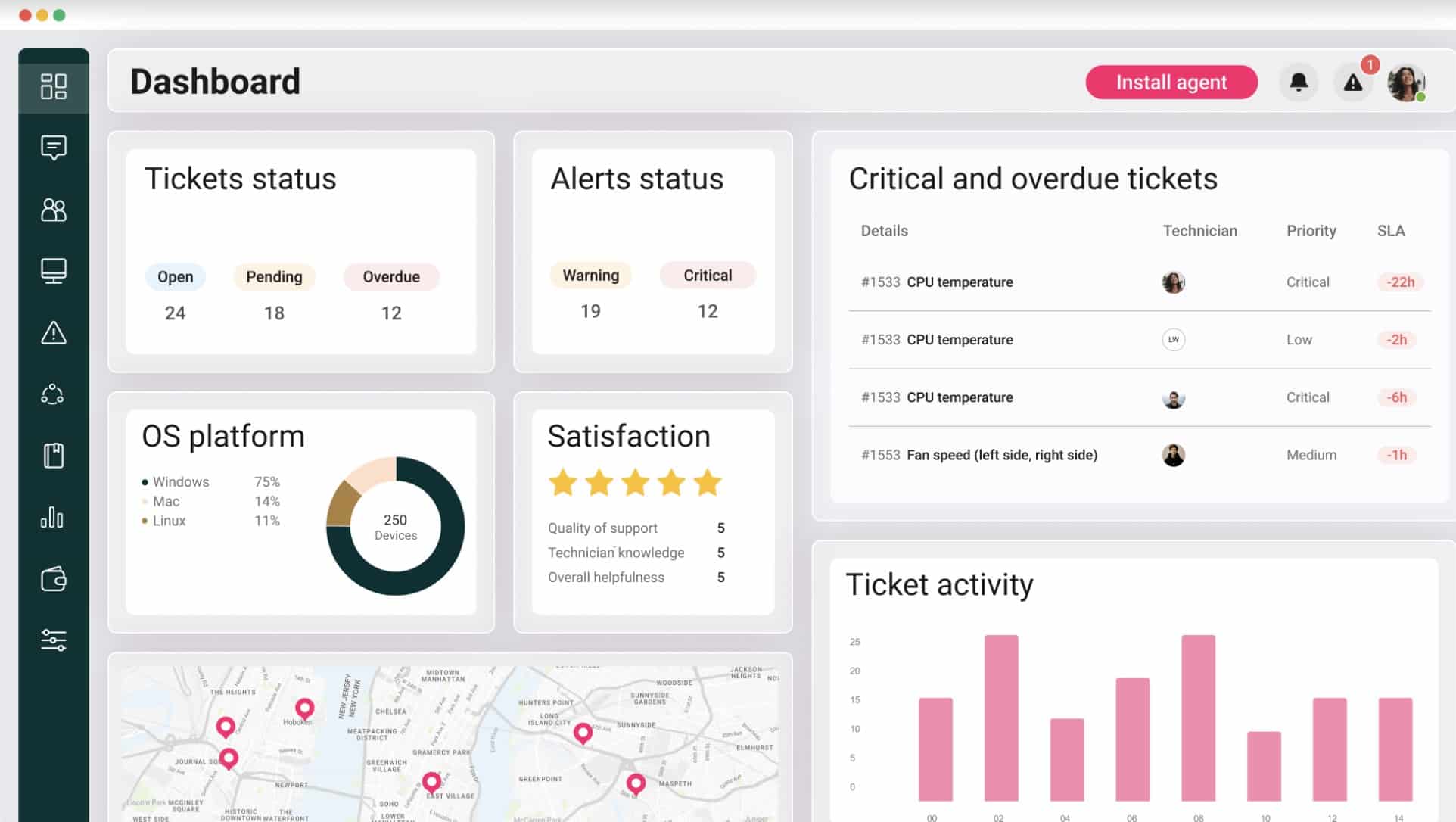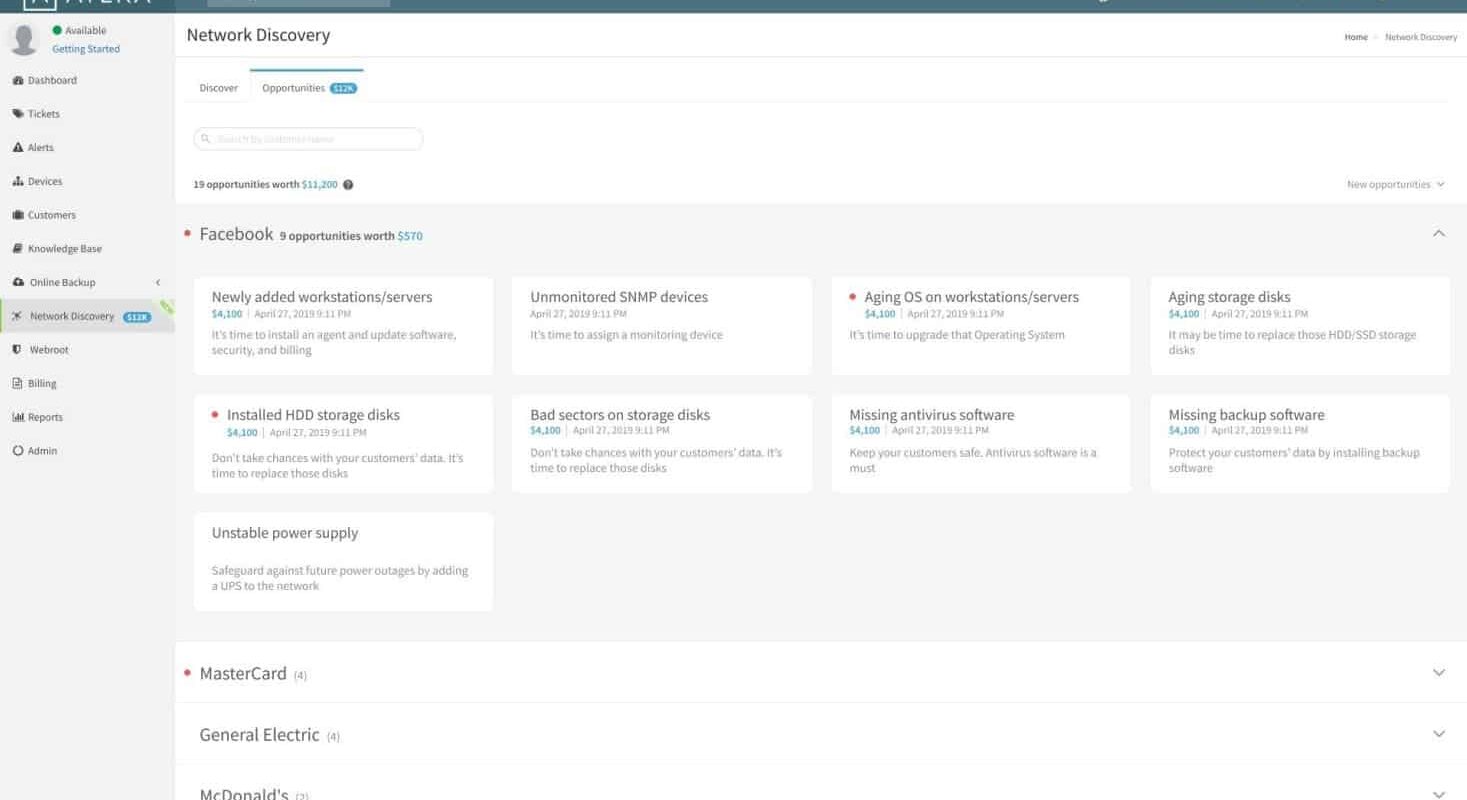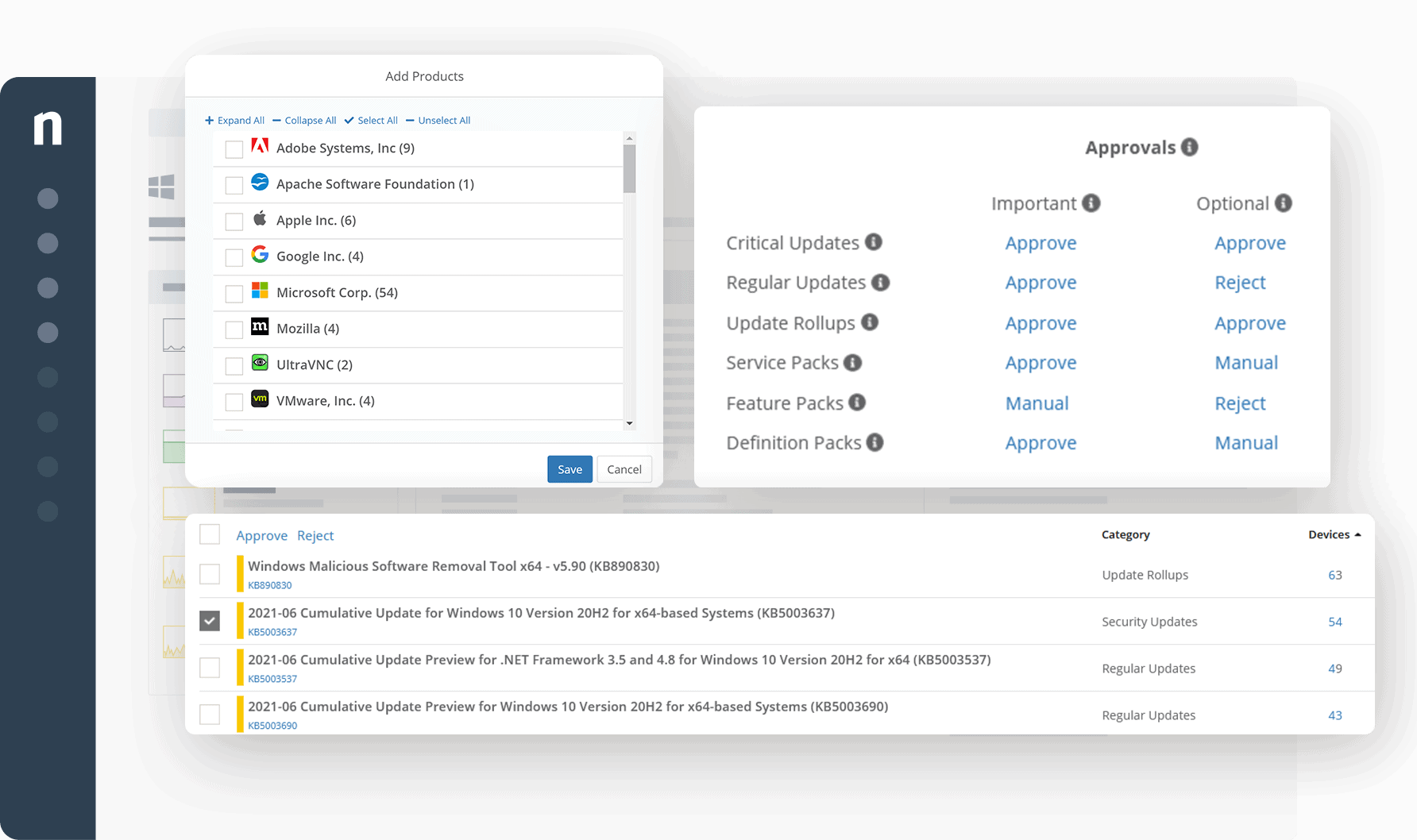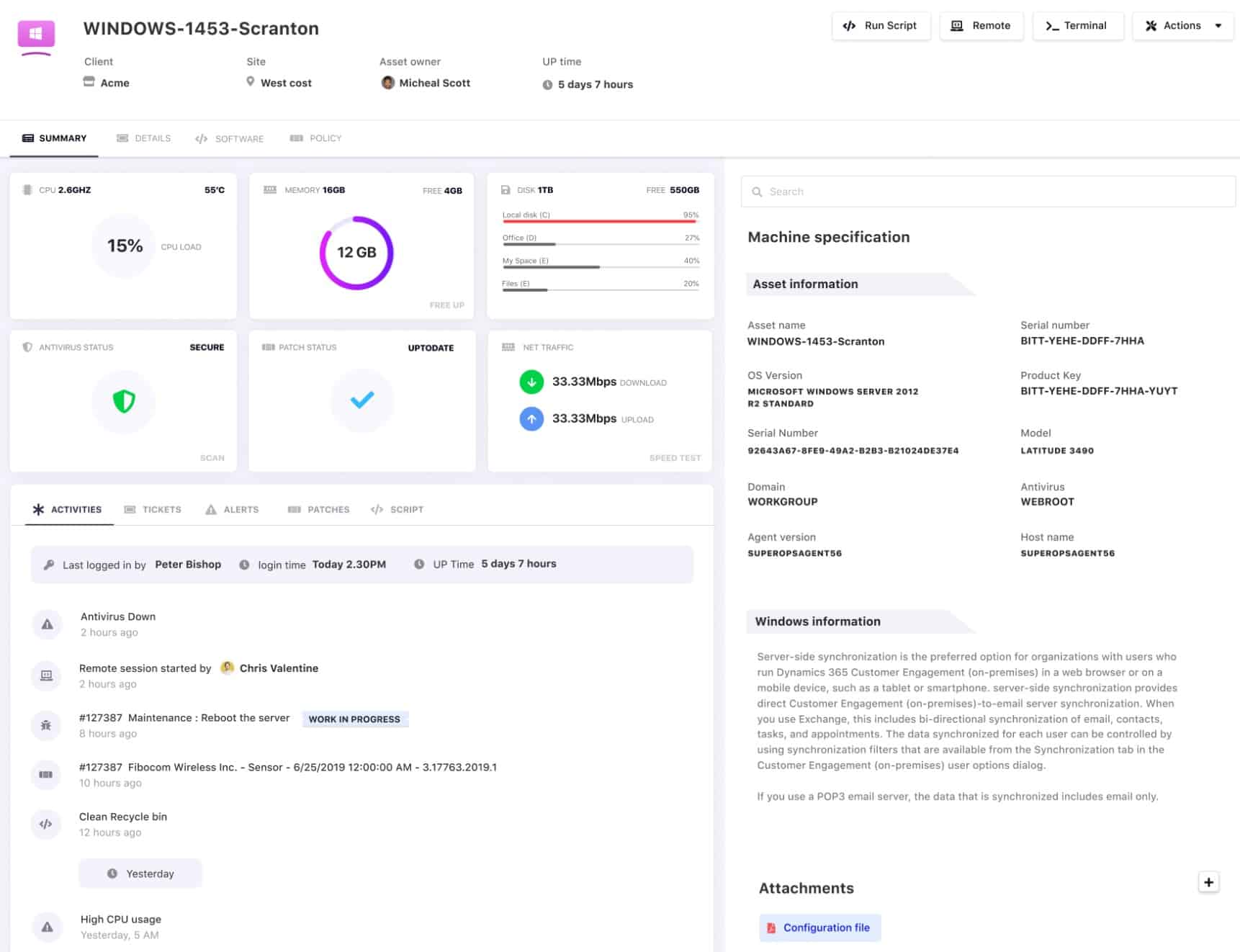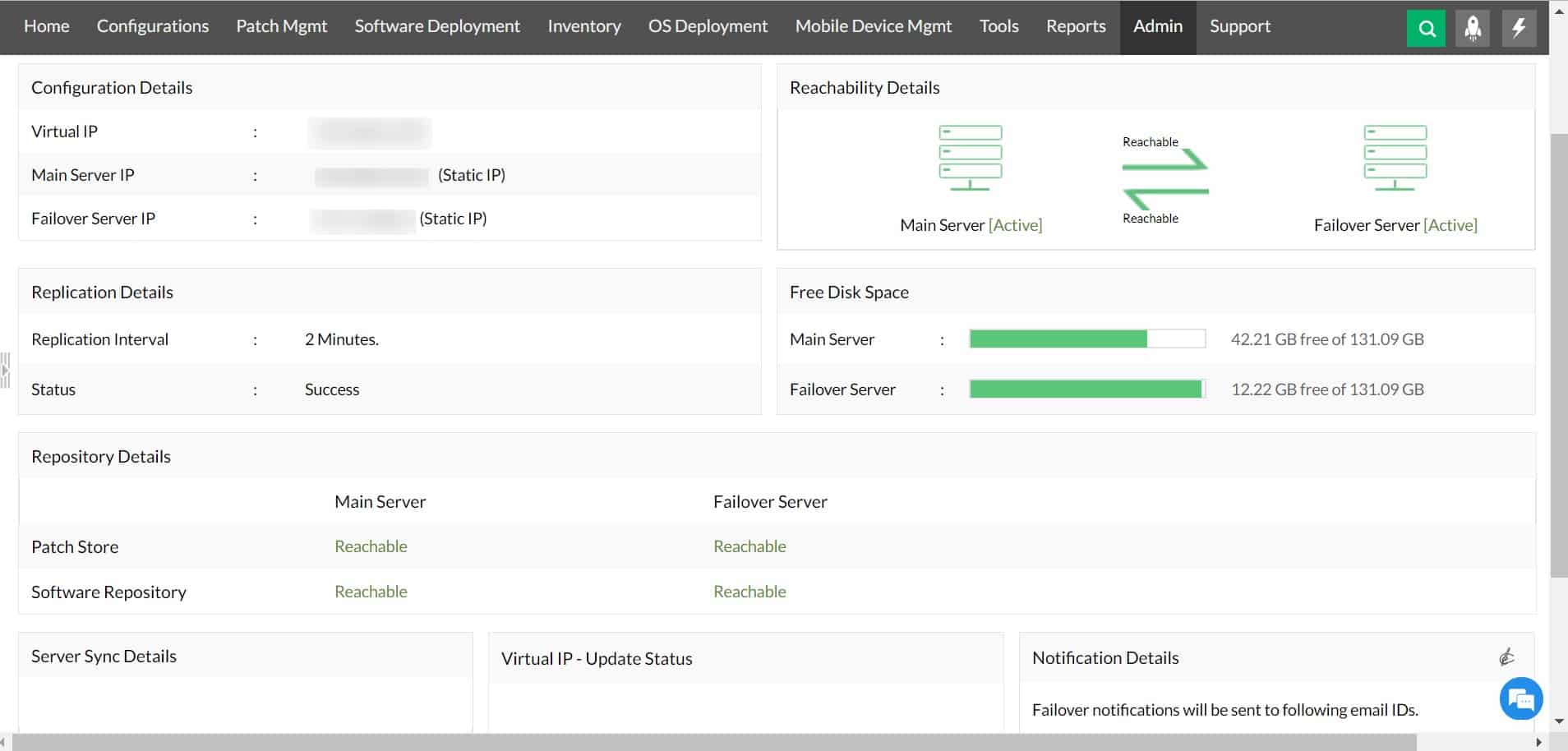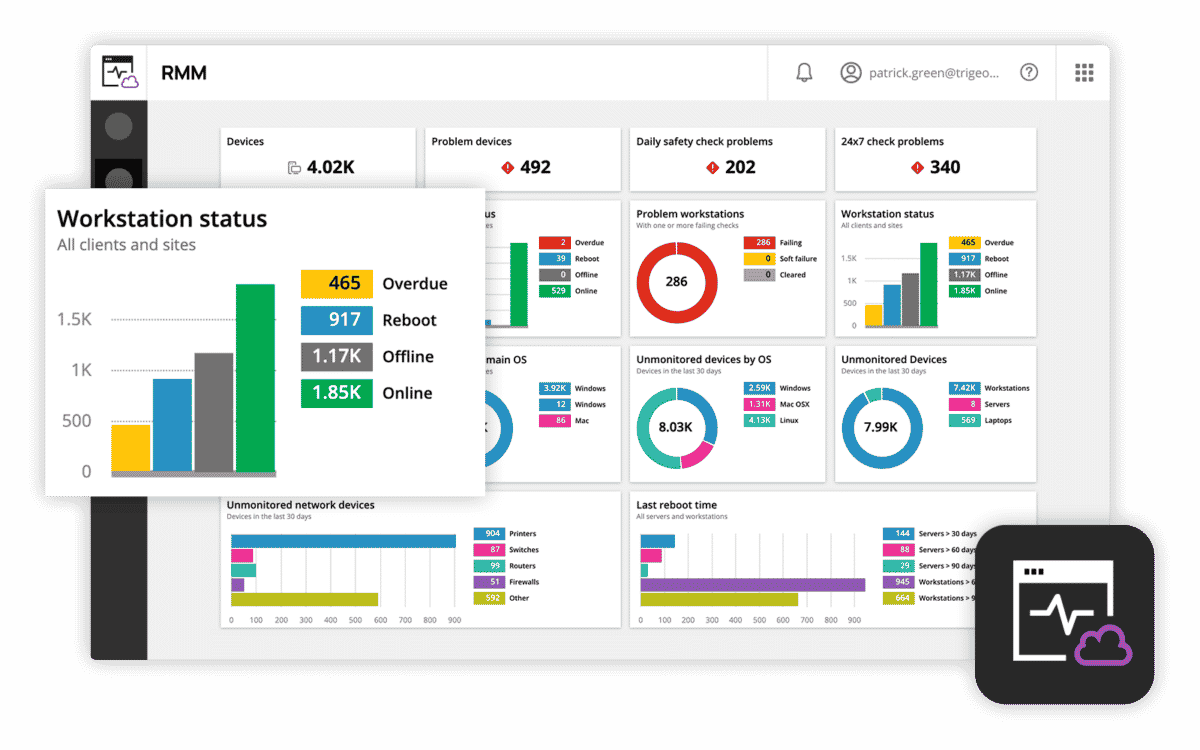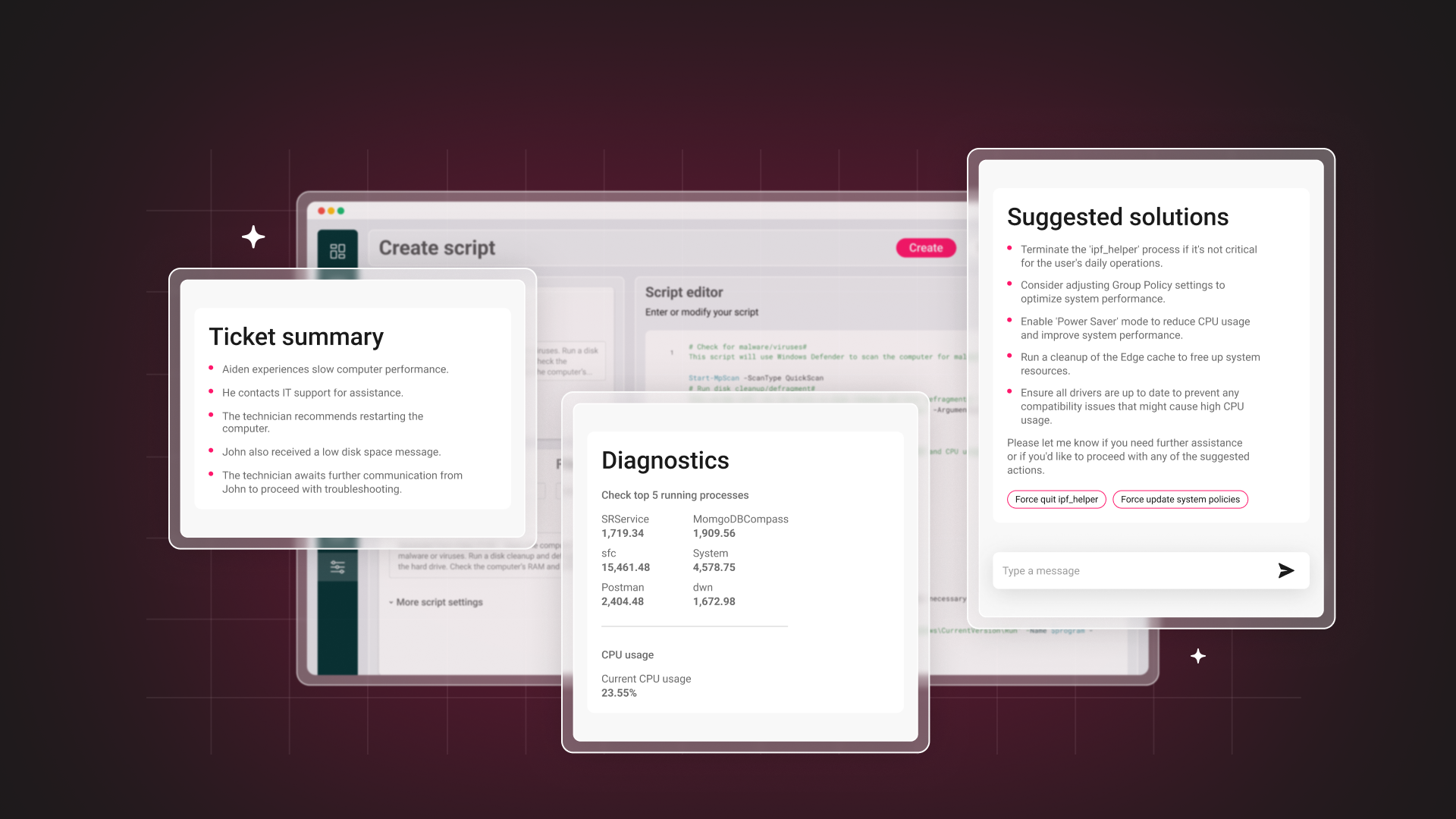We may earn a commission if you make a purchase through the links on our website.
The Best Patch Management Software & Tools
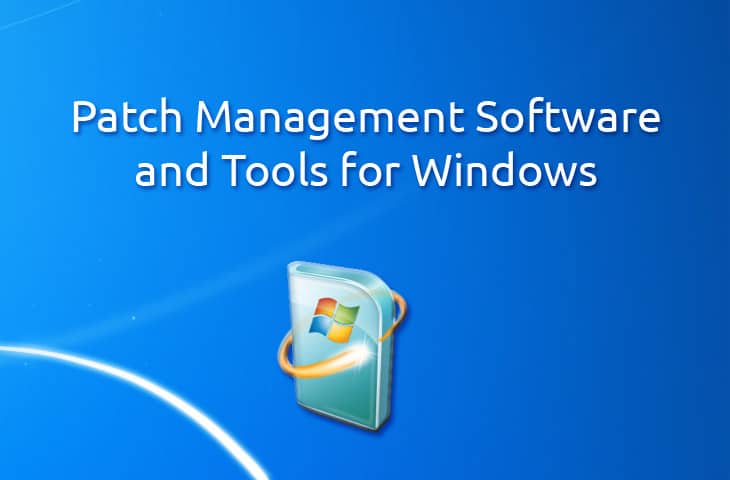
UPDATED: March 31, 2025
Patching your servers, desktops, laptops and any other system in your network will either save you or cripple you. For this reason, we're going to review the Best Patch Management Software and tools for you to ensure all updates, patches and critical services packs are continually being installed and updated.
In recent months, exploits for Windows systems have been made public by various hacker groups that have been subsequently used for exploiting those vulnerabilities and exposing systems to massive breaches and ransomware viruses. Many of these cryptowall or cryptolocker/ransomware viruses are bringing down businesses, schools, home users and even hospitals.
Here is our list of the best patch management tools & software:
- Atera – EDITOR'S CHOICE A cloud-based platform of remote monitoring and management systems that includes an automated patch manager. The company also offers bundles that provide business management modules for managed service providers and all editions include a ticketing system. Get a free trial.
- NinjaOne Patch Management – FREE TRIAL Formerly NinjaRMM, is a remote monitoring and management (RMM) system with an integrated patch manager for Windows, macOS, and the software products of 135 third-party suppliers. A cloud-based platform. Start a 14-day free trial.
- SuperOps – FREE TRIAL This package of remote monitoring and management tools includes an automated patch manager for Windows and macOS. Start a 14-day free trial.
- ManageEngine Patch Manager Plus – FREE TRIAL A suite of software and operating system management utilities that covers Windows, Windows Server, Linux, and macOS. Runs on Windows Server and Linux.
- N-able N-sight Patch Management – FREE TRIAL A package of remote monitoring and management tools that include a patch manager. Delivered from the cloud.
- GFI LanGuard A combined vulnerability scanner and software manager that includes a patch manager. Runs on Windows Server.
- Pulseway WSUS Part of a cloud-based remote monitoring and management platform, this patch manager can update Windows, macOS, and Linux, plus third-party software.
- Syncro This cloud-based package of tools for managed service providers includes a patch manager for endpoints running Windows.
- SecPod SanerNow Patch Management A cloud-based cyber-hygiene endpoint management and security system that includes a patch manager with associated vulnerability scanner and asset manager.
- Kaseya Part of Kaseya VSA, which is a remote monitoring and management system, this is a patch manager for Windows, macOS, and third-party software.
- Cloud Management Suite This patch manager is part of a cloud-based remote monitoring and management suite.
- SysAid A cloud-based platform for system management tools that includes a patch management module. It patches Windows Server and endpoint OSes plus a list of third-party software.
- ITarian Formerly known as Comodo ONE, this is a remote monitoring and management suite that includes a patch manager covering Windows and Linux.
- AutoMox A cloud-based vulnerability scanner that will patch Windows, macOS, and Linux devices.
Having a proper patch manager software tool implemented in your network will save you from dealing with many of the issues from above – along with many sleepless nights of installing patching manually.
Some admins and network engineers would argue having WSUS and/or SCCM (System Center Configuration Manager) in place will solve the patch management issue – and in some cases its true. But there are caveats and downfalls to utilizing a Microsoft-based software solution. WSUS is, at times, complicated and not as friendly as it should be to use, as well as the issue of only being able to manage Windows updates.
SCCM, on the other hand, demands a team to manage it, incurring more costs on top of the licensing costs involved already. This is why we recommend a third-party patch manager to help you cover all your bases and all systems and software that you have in production.
Our methodology for selecting a patch management tool
We reviewed the market for patch management software and analyzed tools based on the following criteria:
- Know your organization's size, number of devices, and other specific features if required.
- Research user reviews, ratings, and recommendations from other users or IT professionals.
- List out the features you need. Look for advanced features like automated patch deployment and reporting capabilities, and check for compatibility with your current systems.
- Evaluate its upfront fees, subscription costs, and additional expenses.
- Don't forget to go for a trial period or demo to understand the software in detail.
- Make sure it has a good level of customer support and regular updates.
The Best Patch Management Software
Below is a list of software that will assist in keeping all systems up to date and secure without much effort and minimal configuration.
1. Atera – FREE TRIAL
Atera is a package of software for managed service providers. The bundle of services includes a remote monitoring and management (RMM) service that has a patch manager built into it. The system is able to patch devices running Windows and macOS.
Key Features:
- Remote Monitoring and Management: Users can manage and monitor limitless patches remotely through its Remote Monitoring and Management and PSA (Professional Services Automation) platform.
- Superior Patch Automation: Patching is provided automatically for both Windows and third-party apps.
- AI-Powered Script Generator: Executes your patching process smoothly by generating complex scripts using AI.
- Proactive Alerts and Monitoring: Proactive alerts and monitoring tools improve the efficiency of healthcare services.
Why do we recommend it?
Atera provides comprehensive services such as IT automation, custom scripting, network discovery, ticketing, reporting, real-time notifications, and patch management. It makes work easier for admins as the tool identifies and distributes patches efficiently on both macOS and Windows systems via a centralized interface. Furthermore, users can also perform reboot distant systems as necessary. Overall, with lots of cool features, it is an invaluable tool for admins to carry out IT administration hassle-free.
As well as updating the operating systems, the Atera patch manager is able to patch applications, such as Chrome, Zoom, Skype, Dropbox, and Adobe. The service detects new versions and copies over the installer, saving it in the cloud storage space that is included with each plan. Operators can choose whether to let the service install patches automatically at the next available maintenance window.
Who is it recommended for?
IT specialists and professionals looking for effective patch management solutions are advised to choose Atera. With the help of its platform, administrators can create reports based on Microsoft knowledge bases and quickly install any necessary patches. They can also customize reports to meet patching demands. Apart from admins, users can also see and track the patch status. Basically for the IT department version, Atera has four subscription levels ranging from Professional to Enterprise. Depending on the need, users can choose the flexible subscription option to manage their IT infrastructure.
Pros:
- All-in-One Patching Solution: Best all-in-one solution that provides Future Simplified Management (RMM, PSA, and Patch).
- User-Friendly Interface: Simple interface that facilitates the website setup and deployment.
- Cloud-Based: Users can access and manage patches from anywhere on the cloud.
- Supports Cost per Technician: On-the-bill quotations for fixed costs per technician, not depending on the endpoint, can be cost-effective for MSPs.
Cons:
- Limited Customization: Limited possibility of getting customizations from more skilled users or adapting them to particular enterprise needs.
Atera offers three plans and all of them include the Patch Manager. Prices start from $129 per technician per month (Pro), $179 per technician per month (Growth), and $209 per technician per month (Power). You can get a free trial.
EDITOR'S CHOICE
Atera is our top pick for a patch management tool because it includes the patch management function in with a long list of other endpoint and network monitoring and management services. There are many plans for the Atera cloud-based SaaS system and all of them include a Help Desk ticketing system. This can be used to channel all tasks to a support team. Automated endpoint management features include a software inventory that forms the basis of the patch manager. The patch manager screen can also be used to schedule automated endpoint maintenance tasks and to run custom scripts.
Download: Start a FREE Trial
Official Site: https://www.atera.com/signup/
OS: Cloud-based
2. NinjaOne Patch Management – FREE TRIAL
NinjaOne (formerly NinjaRMM), is an SaaS remote IT monitoring and management solution to help you plan, deliver, and operate any IT service. Patch management is one of the important tasks that any system management team needs to perform, and an automated patch manager is integrated into the NinjaOne package.
Key Features:
- Multi-OS Compatibility: From a single interface, the user can manage patching processes across a wide range of operating systems, including Windows, Mac, and Linux.
- Live Patch Monitoring: Live monitoring of patch statuses and system vulnerabilities, offering immediate alerts and responses to critical issues.
- Automated Checks: Runs automated checks to ensure systems are continuously in compliance with internal standards and external regulations.
- Patch Rollback: Ability to roll back patches that cause issues, ensuring system stability and uptime.
Why do we recommend it?
NinjaOne Patch Management makes patching simpler overall and is the reason we recommend using it. Identification of patches, approval for deployment, and reports are done swiftly through the help of automation. Administrators have complete control of the process of patching for every device, authorizing and scheduling updates when needed. Patching across multiple devices could be made easier and more efficient through the setting of patch policies. In addition, they can modify patches immediately if necessary.
This solution helps you keep your endpoint software up to date and secured, with its simplified patching solution. You can start patching tasks with out-of-the-box settings and create detailed patch reports. With NinjaOne you can automate patching for Windows platforms and third-party software from over 120 different vendors.
What is unique about NinjaOne?
With the help of the NinjaOne policy framework you can customize scans and updates for any number of devices, whether is for a single or a group of devices. You can also allow fast patch deployment approval or rejection through patch management automation.
Who is it recommended for?
If you are an admin who requires real-time insights into patch statuses to detect susceptible devices quickly, NinjaOne Patch Management is for you. It's perfect for people who need thorough reports on endpoint compliance so they can give important stakeholders access to extensive data. NinjaOne Patch Management enables administrators to efficiently monitor and manage the security of their networked devices by providing real-time visibility and customizable reporting options.
Pros:
- Clean Interface: Features a clean, intuitive interface that simplifies the management of patches across networks.
- Handles Maintenance Tasks: Highly capable of automating routine maintenance tasks and reducing manual labor.
- Real-Time Alerts and Updates: Provides real-time alerts and updates about system status and vulnerabilities.
- Scalable: Efficiently scales from small businesses to large enterprises without significant changes in performance.
Cons:
- Limited Customization Options: While some users may find the customization options for reporting and alerts somewhat limited
The price is not listed in the official site, but you can get a quote. To download NinjaOne, request a 14-day free trial from its official site.
3. SuperOps – FREE TRIAL
SuperOps is a SaaS package that provides remote monitoring and management (RMM) tools. This system is designed for use by managed service providers but it can also be useful for IT departments supporting their own corporate systems.
Key Features:
- Artificial Intelligence: Predicts patch-related issues and optimizes the patching schedule based on system usage and threat intelligence.
- Endpoint Management Tasks: Combines patch management with other endpoint management tasks, such as asset tracking and maintenance in a unified platform.
- Full Deployment: Automated testing environment to validate patches before full deployment to prevent disruptions.
- Custom Patch Deployment: Allows the creation of custom patch deployment sequences tailored to the specific needs of the business environment.
Why do we recommend it?
SuperOps is recommended for businesses that need quick support. This tool is known for typically responding within 30 minutes regardless of time zones. Its cloud-based MSP platform is designed with flexibility and ease of use, fulfilling the MSP's requirements. As an RMM platform, it allows MSPs to remotely access client systems, address issues, enforce policies, and communicate with clients and stakeholders from a single interface.
This package includes a patch manager that is able to update Windows and macOS automatically. It can also be used to update the software packages that run on those endpoints. The system rolls out packages automatically at the next available maintenance window, which an administrator needs to define in the SuperOps console.
Who is it recommended for?
SuperOps tool is specifically tailored for IT operations teams and system administrators. It offers a patch management system that actively tracks software versions to keep users up-to-date and mitigate security risks and potential breaches by identifying outdated applications that need urgent updates across devices or clients. Furthermore, its deployment system enables users to filter bulk updates efficiently before sorting, filtering, and applying them as desired.
Pros:
- Capable of Handling ITSM Processes: Utilizes AI to enhance the efficiency of patch management and other ITSM processes.
- No Need for Multiple Tools: Combines RMM, PSA, and patch management in a single platform, reducing the need for multiple tools.
- Cloud-Based: Fully cloud-based, providing flexibility and accessibility from anywhere.
- Follows Standard and Compliance: Helps ensure devices are always in compliance through automated processes.
Cons:
- Lacks in Advanced Features: Being relatively new in the market, may lack some advanced features found in more established competitors.
There are four plans available for SuperOps. The first of these is a PSA-only package and that doesn’t include the Patch Management module. The other three packages, however, do.
The packages with patch management included are: Standard RMM-only for $99 per technician per month (billed annually), Pro Unified Basic for $99 per technician per month (billed annually), and Pro Unified Advance for $159 per technician per month (billed annually). Get a 14-day free trial.
4. ManageEngine Patch Manager Plus – FREE TRIAL
ManageEngine has recently added a great new tool to their already great network monitoring software suite known as “Patch Manager Plus“. They offer a seamless, simple to use platform to keep Linux, Mac and Windows systems updated, as well as over 250 third-party applications.
Key Features:
- Wider App Support: Supports a broad array of applications and systems, including Microsoft, Mac, Linux, and third-party applications.
- Detailed Deployment Policies: Creates detailed deployment policies to govern when and how patches are deployed, ensuring minimal disruption.
- Robust Patch Management Capabilities: Extends patch management capabilities to mobile devices running iOS and Android.
- Centralized Console: Patch systems across various locations from a centralized console are ideal for remote and hybrid work environments.
Why do we recommend it?
ManageEngine Patch Manager Plus offers robust patch management features that are accessible both by cloud service and on-premises. It automates patch deployment across Windows, macOS, and Linux endpoints such as servers and desktop systems, as well as virtual machines and roaming devices. It covers over 850 third-party apps for Windows, macOS, and Linux software for comprehensive and efficient patching across many IT environments.
Some of the options they provide with their solution include:
- Patch Compliance
- Real-Time Audits and Reports
- Approve/Decline Patches depending on Severity and Priority
- Implement Test Groups of computers
- Extensive list of 3rd-party Application support
Who is it recommended for?
ManageEngine Patch Manager Plus is of great value to system administrators and IT professionals looking for effective patch management solutions. Its centralized web interface allows administrators to scan endpoints for missing updates and test patches before deployment, assuring system stability. With prebuilt and tested packages for third-party programs, patching becomes simplified and hassle-free. As an admin, you can modify deployment policies to suit their business objectives, setting installation and reboot choices for each endpoint.
Pros:
- Prevents Human Error: Automates patch deployment, significantly reducing the chances of human error.
- Fits Most Business Needs: Allows for highly customizable patch deployment policies to fit varied business needs.
- Pre-Deployment Testing: Enables pre-deployment testing of patches to ensure compatibility and performance.
Cons:
- Cluttered UI: New users report that the user interface can be cluttered and confusing.
Get started by downloading a 30-day free trial.
5. N-able N-sight Patch Management – FREE TRIAL
The cloud patch management software that forms part of N-able N-sight is a SaaS service, so you don’t need to install and host it on your own premises in order to use it. However, you do need to install an agent program for the entire RMM suite. RMM stands for “remote monitoring and management” and this system of software includes all of the tools that a managed service provider (MSP) needs for technicians to support the system of client companies. The remote functions would also be suitable for use by a corporate IT department that supports many remote sites.
Key Features:
- Cloud-Based Interface: Allows the management of patches anywhere and anytime.
- Robust Patch Control: Robust approval processes for patches, giving administrators control over what is deployed and when.
- In-Depth Configuration Setting: Tailor patching processes to the specific needs of each device or group.
- Advanced Dashboards: Reporting tools that provide insights into patch successes and vulnerabilities.
Why do we recommend it?
We recommend N-able N-sight Patch Management to simplify the complex task of keeping software up to date, especially when managing numerous workstations and servers. N-able Remote Monitoring & Management (RMM) provides granular control over patch management policies, allowing users to mitigate the risk of cyberattacks effectively and optimize system performance.
What is unique about N-able N-sight Patch Manager?
The cloud patch management software will automate most of the workflows for keeping operating systems and software up to date. However, it does still allow the technicians some control over what gets applied. The system allows operators to hold back some patches for further investigation. Thus, one patch does not hold up all the updates scheduled for rollout.
Who is it recommended for?
N-able N-sight Patch Management is recommended for IT professionals and organizations managing multiple workstations and servers. It's particularly beneficial for those seeking to streamline patch management processes, enhance cybersecurity defenses, and optimize system performance. Whether you're an IT administrator responsible for maintaining software updates across a large network or an organization aiming to mitigate cybersecurity risks, N-able N-sight Patch Management provides the necessary tools and control to effectively manage patching requirements.
Pros:
- Control All Installed Patches: Allows detailed customization of patch approval processes, providing control over what gets installed.
- Manage from Anywhere: Facilitates management from anywhere, enhancing operational flexibility.
- Powerful Reporting Tools: Helps maintain compliance and security standards.
Cons:
- Tough Initial Setup: Setup and integration for your current systems can be complex, especially for users unfamiliar with similar systems or lacking IT expertise.
Start with a 30-day free trial.
6. GFI LanGuard
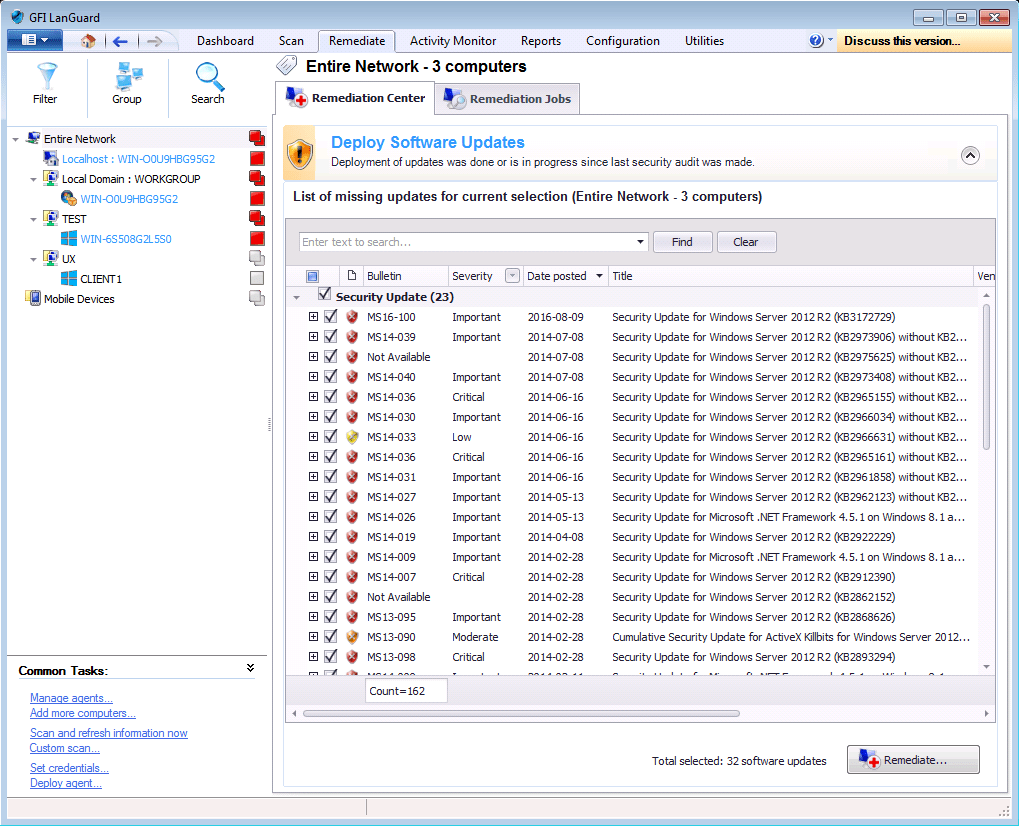 GFI LanGuard is another great solution for patch management and they offer not only the basic platform updates, but Windows Phone, iOS and Android as well. They conduct over 60,000 vulnerability assessments and ensure that your network systems and devices are kept up-to-date with the latest patches and updates.
GFI LanGuard is another great solution for patch management and they offer not only the basic platform updates, but Windows Phone, iOS and Android as well. They conduct over 60,000 vulnerability assessments and ensure that your network systems and devices are kept up-to-date with the latest patches and updates.
Key Features:
- Vulnerability Detection and Remediation: Integrates patch management with network security scanning to detect and remediate vulnerabilities.
- Software Audit Tools: Tracks licensing, installations, and unauthorized software across the network.
- Schedule Patch Installations: Allows scheduling patch installations during custom maintenance windows to minimize business impact.
- Multiple Languages Supported: Supports multiple languages, facilitating deployment in diverse geographic locations.
Why do we recommend it?
We recommend GFI LanGuard for its comprehensive endpoint protection capabilities. It allows administrators to identify vulnerabilities and patch software on desktops, servers, and virtual machines, both locally and remotely. LanGuard ensures robust security across Windows, macOS, and Linux devices by scanning networks for missing patches and other vulnerabilities. It also supports over 50 third-party applications from major vendors like Adobe, Apple, Microsoft, and more, making it a versatile solution for maintaining software security.
Who is it recommended for?
LanGuard is recommended for IT administrators and teams responsible for managing network security and patching across large networks. Its web-based reporting interface enables administrators to export reports in various formats and schedule automatic email delivery. For extensive networks, administrators can deploy multiple LanGuard instances and generate aggregated reports for comprehensive analysis.
Pros:
- Gives Whole Network Security: Not only fixes the weak areas in a network, but also ensures its security.
- Manage OS and Apps: Serves almost all possible operating systems and applications.
- Flexible Admin Work: Vital in ensuring the standards are easy, flexible, and effective to administer
Cons:
- Outdated Interface: Often out of date and lacks simple features when compared to the newer solutions.
Free trial and then between $10 – $25 per user thereafter!
7. Pulseway WSUS
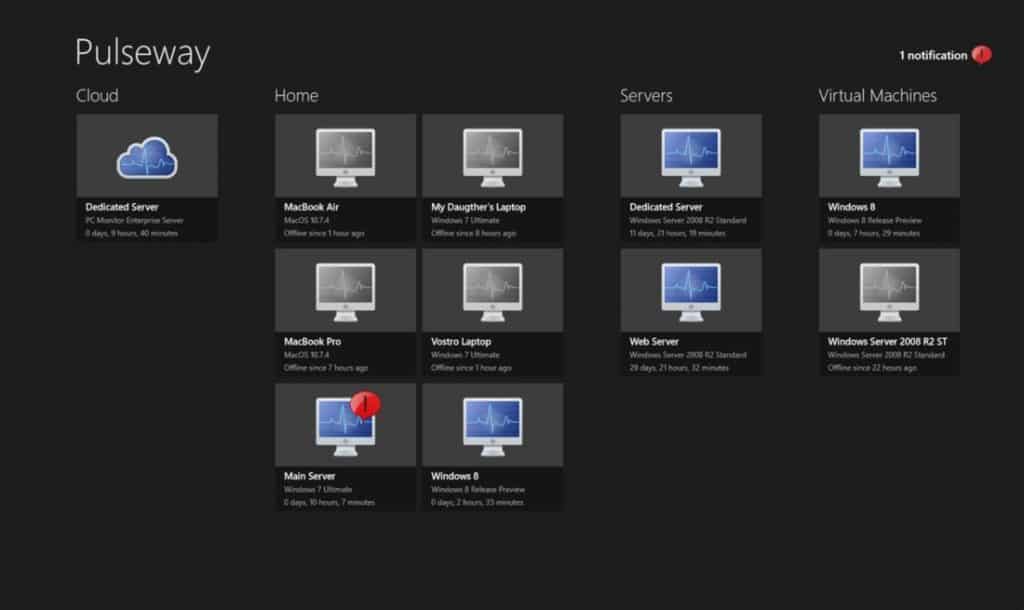
Pulseway WSUS (Windows Server Update Services) is a patch management Windows server module. It notifies you when a new update is available so you can easily review and approve the updates from any device. With Pulseway WSUS' API you can remotely monitor and manage Windows, Linux, and MacOS, including any third-party application, using the mobile app or web browser.
Why do we recommend it?
We recommend Pulseway WSUS because it's trusted by over 13,000 businesses to manage their IT remotely. With its dashboard widgets, you can easily see the patching status of your whole system. It works with all operating systems to keep your endpoints safe and secure. With this software, you can install, uninstall, and update all your programs without any hassle, ensuring your IT environment stays protected and up-to-date effortlessly.
To start with this solution, just install the agent software on the computer that you need to monitoring. For security, all the communication between the application and the monitored device will be encrypted.
What is unique about Pulseway WSUS?
Pulseway was one of the first to develop mobile IT management software. They made it easy to monitor software anywhere you are. The software is also easy to use and very convenient. With WSUS you can find any Windows update and apply it from a centralized place (including a mobile device). Then you can search according to update approval state or update installation status.
Who is it recommended for?
Pulseway WSUS is used by network specialists and IT administrators to automate patch administration throughout their company's IT infrastructure. They make use of its remote management features to effectively apply updates and patches to every endpoint, wherever they may be. They may quickly identify any vulnerabilities or flaws by visualizing the complete environment's patching status with the dashboard widgets. With Pulseway WSUS, network specialists and IT administrators can proactively ensure the security and reliability of their IT systems, guaranteeing peak performance and defense against online threats.
Pros:
- Manage from the App: Mobile app allows administrators to manage patching tasks from mobile devices.
- Easily Connect Modules: Integrates seamlessly with other Pulseway modules for comprehensive IT management.
- Easily Scalable: Scales well to accommodate the needs of both small businesses and large enterprises.
- Customizable Alerts: Provides customizable alerts and notifications to keep administrators informed about patching activities and issues.
Cons:
- Good Tech Knowledge Required: Setting up and configuring Pulseway WSUS may require some technical expertise, especially for users new to the platform.
Pulseway is a pay-as-you-go service, but according to the official site, a pricing estimation starts from $47 per month. Get Pulseway from its official website.
8. Syncro
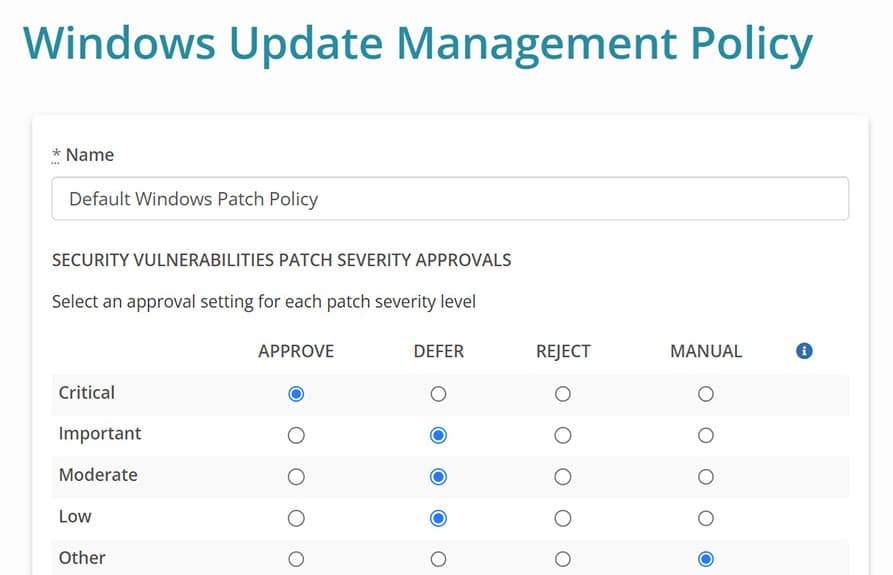
Syncro provides software for managed service providers. That includes professional services automation (PSA) systems for MSP management and remote monitoring and management (RMM) tools for use by technicians when looking after the systems of their clients. The RMM package includes an automated patch manager.
Key Features:
- One Console Platform: Simultaneously connects PSA and RMM components into a single platform.
- Advanced Scripting Engine: Allows you to automate any kind of IT tasks or activities.
- Customized Reporting Capabilities: Provides reporting capabilities that users can customize to get detailed data about operational efficiency and customer service levels.
- Brand Reports: Facilitates rebranding of the interface and reports, allowing MSPs to mark them with their logos and designs.
Why do we recommend it?
We recommend Syncro as it offers extensive remote monitoring and administration capabilities and allows customers to manage IT assets on a large scale. With real-time devices, service, and process monitoring, users will be up to date on the status of their system. Syncro gives alerts in case of issues, which allows for proactive solutions prior to the client's impact.
Who is it recommended for?
This tool is highly beneficial in optimizing the efficiency of your business operations. It is mostly used by Managed Service Provider (MSP) teams for patch management. Syncro incorporates Professional Services Automation (PSA), Remote Monitoring and Management (RMM), remotely accessible IT tickets, and much more. It also provides one interface for managing the entire client's activities. MSP teams can effectively handle contracts and SLAs, handle customer queries while automating billing, and collaborate with each other on the platform.
Pros:
- Automated Script Generation: Includes a potent core that enables the scripting of complex tasks and operations.
- Gives Complete Report: Generates comprehensive reports that enable companies to track their production and customer service effectiveness in detail.
- Personalized Branding: Gives MSPs the opportunity to tag the panel and the reports with their logos for a professional appearance.
Cons:
- Tough to Use for Newbie Users: Extensive features can be difficult to understand for new users or small teams without dedicated IT support.
Investigate the Syncro package further by accessing a 14-day free trial.
9. SecPod SanerNow Patch Management
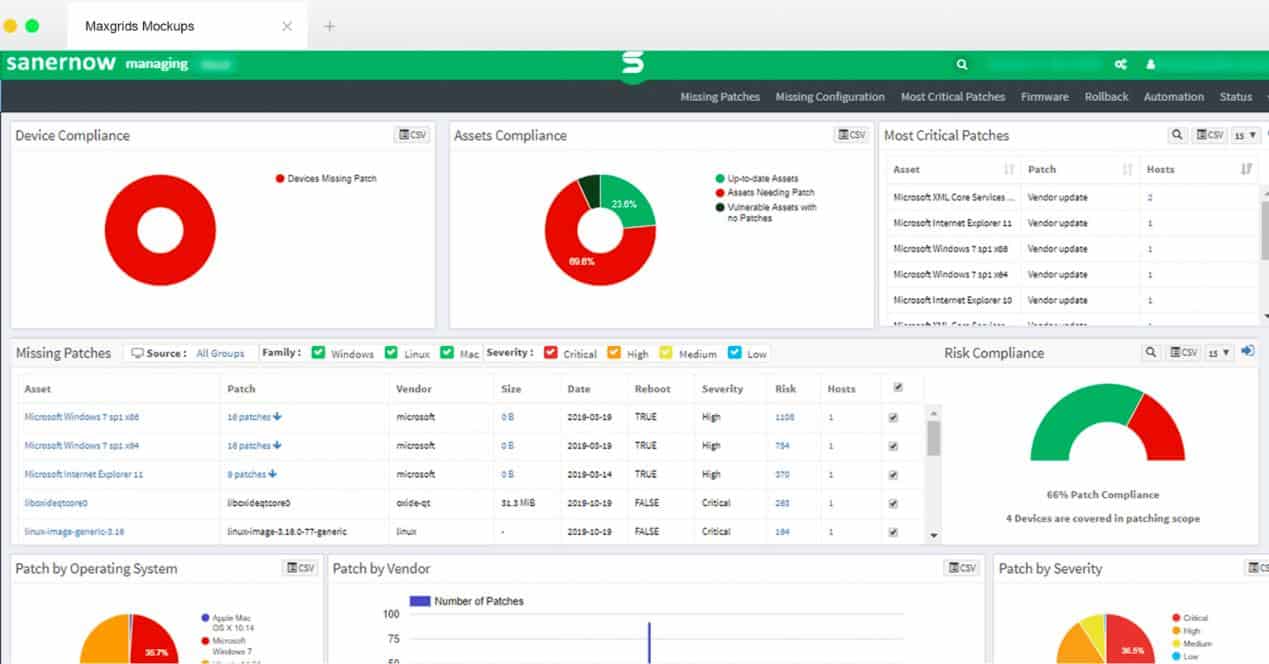
SecPod SanerNow Patch Management is a SaaS system that delivers linked vulnerability scanning, patch management, and asset management. This system is able to supervise the management and security of devices running Windows, macOS, and Linux. The links between the three key functions of his platform coordinate to provide automated workflows.
Key Features:
- Endpoint Security Features: Integrates patch management with endpoint security features to enhance overall security posture.
- Behavioral Analytics: Uses behavioral analytics to monitor systems for unusual activities post-patch, ensuring all changes are benign.
- Virtual Patch Installations: Simulates patch installations in a virtual environment to check for potential issues before actual deployment.
- Detailed Logs and Reports: Maintains detailed logs and reports for audit trails and compliance requirements.
Why do we recommend it?
We recommend SecPod SanerNow Patch Management for its comprehensive automation capabilities. It covers all aspects of patching, from scanning and prioritization to download, testing, and scheduled deployment. By automating these tasks, it reduces manual workload and minimizes the risk of human errors. SanerNow also enables users to create customized automation rules tailored to their organization's needs, facilitating faster and more efficient patching across the network. Overall, it offers a streamlined and effective solution for maintaining system security and compliance.
Who is it recommended for?
SecPod SanerNow Patch Management is used by experienced administrators and IT workers to make patching easy. It automates everything from scanning for patches to determining which ones to install and when. It obtains fresh patches from supported firms fairly rapidly, within 24 hours. This helps keep security threats low. The patches are tested and ready to use straight away. Plus, you may try out new fixes and revert modifications if there's a problem.
Pros:
- Vulnerability Detection: Automatically assesses vulnerabilities and suggests remediation steps.
- Centralized Console: Offers a centralized console for managing patches and security policies.
- Deployed Easily to All Businesses: Scales well and offers flexible deployment options for different business sizes.
Cons:
- Steep Learning Curve: The wide range of features may result in a steeper learning curve for new users.
A free trial is available. The subscription price for SecPod SanerNow is set by negotiation.
10. Kaseya VSA
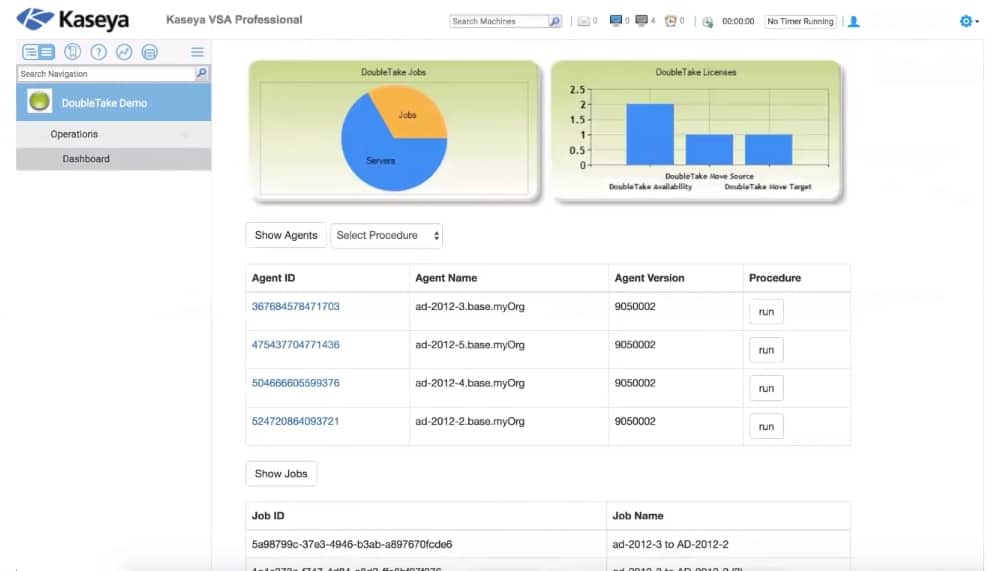
Kaseya VSA’s is a cloud-based IT management and monitoring solution that provides tools for MSPs and IT entreprises. With this software you can manage and secure any kind of IT capabilities. Kaseya VSA Software Management module is a solution that provides central management, complete visibility, and automation to deploy and update all Windows, MacOS, and 3rd party software.
Key Features:
- Testing Environment: Provides a testing environment to evaluate patches before deployment to production systems, reducing the risk of disruptions.
- Customizable Policies: Automates patch deployment based on customizable policies, ensuring consistency and compliance.
- Third-Party Applications: Offers capabilities to manage patches for third-party applications in addition to operating system patches.
Why do we recommend it?
We recommend Kaseya because it's great for monitoring and managing your devices from afar. With features like alerts, discovery, and automation, it's easy to keep everything running smoothly. You can use it to update and patch computers and apps on Windows, macOS, and Linux. Plus, it automatically manages patches, using policies that you can customize to fit your needs. Kaseya also uses scripts to automate tasks like patching, making everything even easier for administrators.
Why is Kaseya VSA special?
Thanks to Kaseya’s policy profiles, you can automate software maintenance across different platforms and perform any patch deployment for devices, on or off the network. Another outstanding feature of Kaseya VSA is its rapid software distribution using the Agent Endpoint Fabric that optimizes the delivery of installers, even if it is destined to a high latent network.
Who is it recommended for?
Kaseya is valuable for network administrators as it offers automated software and patch deployment using scripts, covering all endpoints whether they're connected to the network or not. Admins can override patches and track patch histories for better management. Its policy-based approach ensures consistent software maintenance through customizable profiles, allowing admins to control patch approvals, schedules, and installations. Moreover, admins can set up time windows to prevent patches during critical periods and restrict specific patches from applying to certain machines, enhancing control and security.
Pros:
- Granular Control: Provides granular control over patch deployment processes, allowing administrators to prioritize patches based on severity and business impact.
- Scalable to All Business Sizes: Scales effectively to fit businesses of all sizes, with flexible deployment options.
- Track Minor Activities of Patching: Offers detailed reporting and analytics tools to track patching activities and compliance status.
Cons:
- Might Need Training to Learn: Kaseya's extensive features and functionalities may present a steep learning curve for new users, requiring significant time and training to master.
For price efficiency, the cost is based on the number of endpoints. The price is not published in the website, you have to request a quote. There is a free trial, but you need to request a demo from Kaseya VSA official site.
11. Patch Management by Cloud Management Suite
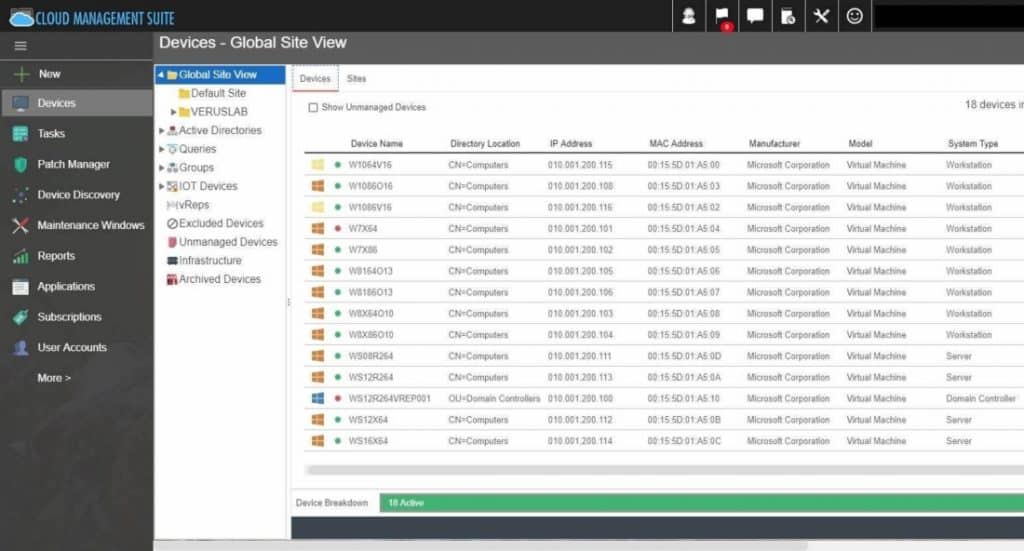
Cloud Management Suite is a cloud-based patch management platform for any type and size of network. It helps you manage your IT infrastructure, find vulnerabilities and fix them instantly. This solution allows you to manage all network devices and endpoints on or off the network, from the cloud and without the help of agents.
Key Features:
- Security Scanner: Scans every point of your system configuration, files, etc, to check for cyber attacks and vulnerabilities.
- Cortex Automation: Pre-built templates and automation tools that will make your tedious tasks easier.
- Mobile Device Management: Manage and configure your iOS, Linux, and Android inventory from anywhere.
- Cyber Security Remediation: Quickly finds the vulnerabilities and misconfiguration from a single console and get it fixed instantly.
Why do we recommend it?
We recommend Cloud Management Suite because of its powerful automation engine, Syxsense Cortex, which automates essential tasks like patch scanning, deployment, and vulnerability remediation. This helps you stay on top of your enterprise's security and performance. With persistent observability provided by Syxsense, you can gain awareness and control over your entire environment. Plus, its unique endpoint management architecture gives you real-time visibility across all your devices, ensuring efficient management and monitoring.
The main components of Cloud Management Suite are Patch Management, Inventory Discovery, Remote Control, and Software Distribution. The patch management supports updates for different vendors such as Microsoft, Adobe, Java, Chrome, etc.
What Makes it Special?
Thanks to its amazing built-in reporting feature, IT managers can show detailed patching status reports to auditors and executives. The report provides summaries and in-depth information with customized parameters. IT managers also love Cloud Management Suite because its console is really easy to use and highly functional.
Who is it recommended for?
Cloud Management Suite is beneficial to experts as it provides extensive filter and query options for prioritizing patches, ensuring that the most critical updates reach the most vulnerable devices first. With strict detection logic in place, only necessary updates are installed on each device, minimizing unnecessary deployments and potential disruptions. This ensures that software remains up to date, deployments are streamlined, and the overall environment is kept secure, allowing experts to manage and maintain system integrity effectively.
Pros:
- Cloud-Based Architecture: Simplifies deployment and eliminates the need for on-premises infrastructure.
- Cost-Effective: Provides a cost-effective solution for patch management with flexible pricing options.
Cons:
- Internet-Dependent: Relies on stable internet connectivity for operation, which could be a limitation in environments with unreliable internet connections.
The price starts at $2.00 per endpoint per month. Request a quote, to get a closer estimate for a price according to your requirements Request a free trial for a 14-days period.
12. SysAid Patch Management
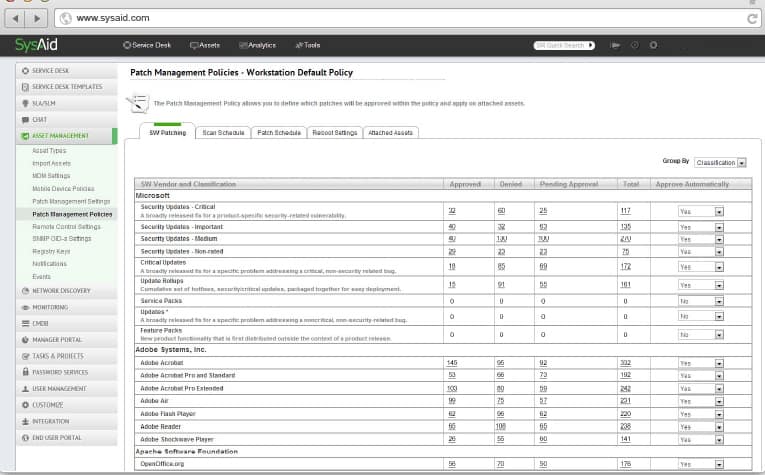
SysAid Patch Management is a cloud-based IT management service and Service Desk solution. It assists users located in any network size to resolve technology problems. Some of the most relevant features include help desk automation, asset management, patch management, network monitoring, performance analysis, and reporting.
Key Features:
- Unified Platform for IT Management: Manage entire IT services in one place including patch management, asset management, and help desk support.
- Automatic Deployment: Automates patch deployment to make sure your systems are up-to-date with the latest security patches and updates.
- Change Management Capabilities: Offers change management capabilities to track and manage changes made during the patching process, ensuring accountability and compliance.
- Self-Service Portal: End-users can request assistance and track the status of their requests.
Why do we recommend it?
We recommend SysAid for its comprehensive Patch Management feature, which includes an audited patching process facilitated by SysAid Change Management. This ensures that all patch-related changes are meticulously documented, accurately executed, and aligned with internal or external regulations. With SysAid, organizations can maintain a robust patching process, enhancing security and compliance measures while mitigating risks associated with software vulnerabilities. It's a reliable solution for effectively managing patching activities and ensuring the integrity of IT environments.
SysAid is integrated into SysAid IT Asset Management and helps Windows servers and endpoints, be updated with the latest patches. With this solution you can have an overview of the patches working on active devices on your network. You can also customize automatic processes to deal with the entire patch management. The software is supported by Microsoft and third-party applications such as Adobe Flash, Firefox, Chrome, Java, Apple iTunes, etc.
What is Special about SysAid Patch Management?
The software comes with a great auditing patching process. This helps you ensure that all changes related to patches are performed correctly, well documented, and that they comply with any regulations.
Who is it recommended for?
SysAid is a good choice for IT administrators who require complete patch management solutions. It gives an overview of the most relevant patches for every currently active IT asset and allows for the modification of automated patch management policies. Administrators can manage patches manually on a variety of assets or just one when needed. Administrators can also monitor the progress of patches and analyze the outcomes efficiently, which ensures efficient administration of IT infrastructure.
Pros:
- Easy to Connect to Helpdesk: Seamlessly integrates patch management with help desk support, enabling efficient issue resolution and ticket management.
- Customize Workflow: Customize workflows and processes to align with organizational policies and procedures.
- Role-Based Access: Provides role-based access control to restrict access to sensitive information and features, enhancing security.
- Use a Handy Mobile App: Offers mobile apps that enable administrators to manage IT operations on the go.
Cons:
- Lacks in User Experience: Some users faced issues with modules. Thus, the module display resulted in poor user experiences.
SysAid Service Desk is offered in three plans; Basic, Full, and A La Carte. Each is suitable for different networks and budgets. The price is not published in the website, but you can contact them to get a quote. Get a free trial of the IT Asset Management and test the patch management capabilities.
13. ITarian Patch Management tool
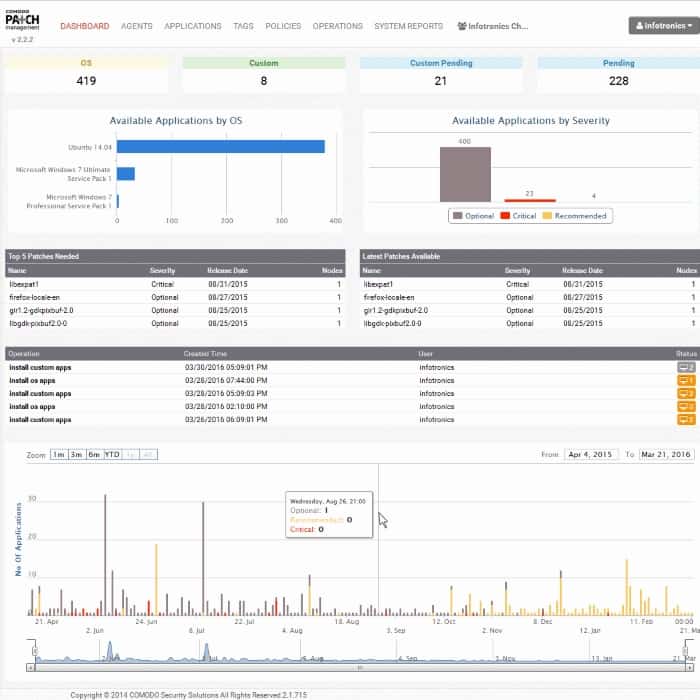
ITarian is a free IT platform that allows remote monitoring and management. The software allows patch management, remote control, customized scripts, auto-discovery and deployment, and service desk. With ITarian you can find which endpoints have vulnerabilities and which ones require patching. Once a vulnerability is found, you can create policies to help you automatically deploy updates to a single or group of endpoints and schedule the process.
Key Features:
- Automated Patch Management: Performs a smooth transition from reactive threat to proactive security posture.
- Drag-and-Drop Functionality: Seamlessly use the tool with drag and drop to personalize custom automation.
- Remote Monitoring and Management: Keeps every program in your system updated by continuous remote monitoring.
Why do we recommend it?
We suggest ITarian due to its comprehensive capability to manage patches. It lets administrators identify vulnerable endpoints, mark them, and then create policies to automate the deployment of patches to specific groups of endpoints. Custom tags allow organizations to be based on business requirements and the option to deploy patches based on severity, vendor, or type-based criteria. Administrators can plan deployments and test patches before approving the deployment, ensuring an optimal security level and smooth administration of patching processes across IT infrastructure.
You can also get a general overview of available updates with the help of reports and dashboard statistics. ITarian helps you deploy updates to Windows and Linux operating systems.
Who is it recommended for?
ITarian is a must-have for IT administrators as well as organizations looking for complete endpoint management solutions. It offers comprehensive reports on hardware software, patches, and updates for managed devices. It also provides insight into the statistics of endpoints and patch statuses via a central interface. ITarian allows quick identification and patching of weak endpoints by tracking patches and managing them in real time.
Pros:
- Offers Free Version: Use free versions and benefit from powerful characteristics and other advanced features.
- Centralized Management Platform: Cloud-based architecture allowing patches to be managed and accessed from a single console.
- Automation: For powerful applications in automation and configuration.
- Lots of IT Management Techniques: Includes various IT management techniques beyond patch management.
Cons:
- Lacks in Power: Many users reported that it may not give you the attention and power that others could.
Free to install, but contact for additional licensing. Get a complete free patch management software and tools for Windows.
14. AutoMox
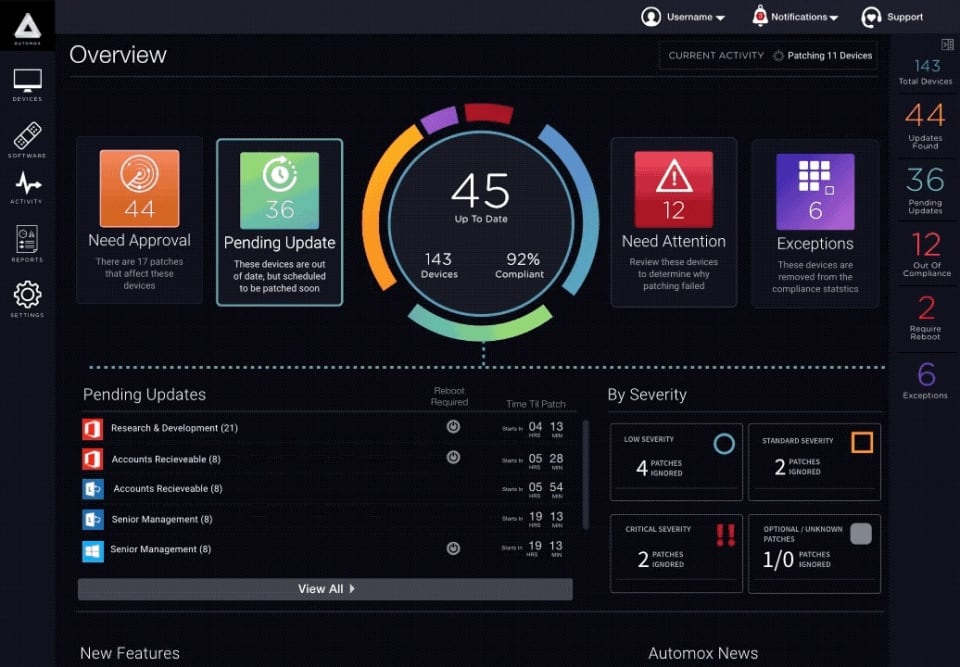
AutoMox is a cloud-based solution that can automate patching and configuration for any device or group of devices in the network. AutoMox tracks, controls, and manages the entire patching process. The solution works with agents and policies, so that you can control the level of patch management automation, flow processes, and configuration deployments.
Key Features:
- Automated Patch Management: Offers a cloud-native patch management solution for modern IT environments to secure all your endpoints.
- Cross-Platform Support: Supports Windows, macOS, Linux, and third-party software.
- Light-Weight Agent: Easily configure policies for automated patching.
- Proactive Reporting: Offers comprehensive compliance reporting and endpoint hardening.
Why do we recommend it?
We recommend AutoMox due to its comprehensive endpoint management capabilities. This tool specializes in remote troubleshooting and also supports patch management for Windows and macOS endpoints, meaning you don't need any additional tools. Patches are easy to handle as it has a single console to manage both OS and third-party application patching and updates. A feature we really liked is that you can smoothly control endpoints as it automatically inventories hardware and software and provides visibility into authorized and unauthorized applications on managed devices.
With this solution, you can get a complete network inventory and learn about the status of the system and its software. This will help you to quickly identify which systems are vulnerable and which ones need immediate updates. Automox allows you to see real-time vulnerabilities in a single dashboard for different platforms, like Windows, Linux, and MacOS.
What's so Great about AutoMox?
The user interface is highly visual and very lightweight. You can easily install the agents remotely without interrupting the user. The dashboard is also very easy to setup and use.
Who is it recommended for?
Automox is recommended for IT administrators and companies seeking greater control over configuration and patch management procedures. With the ability to develop customized scripts, administrators are able to customize their patching schedules, configurations, and patches to meet the specific requirements. Automox provides flexibility in scheduling patches and allows the scheduling of specific times or even automatic deployment upon connection via the internet. The ability to notify and report increases visibility and ensures compliance, which allows companies to control and manage the integrity of their IT infrastructure efficiently.
Pros:
- Cloud-Native: The best fit for modern IT operations that operate in the cloud.
- Easy Deployment: Easy to set up, and can be configured and deployed from anywhere.
- Automox Worklets Catalog: Includes 345 ways to automate tasks, and you can also create a draft script.
Cons:
- Reporting and Analysis: May lack the depth in reporting and analytics offered by more established players.
Automox offers three different pricing plans: Endpoint Monitoring (100% free), Basic Patching ($2 endpoint/month), and Full Platform ($5 endpoint/month). Signup to Automox to get a 15-day free trial.
Conclusion
The importance of having your systems continually patched is more crucial than ever. As we've seen, there are many exploits and vulnerabilities within Windows systems and other network devices that are not made public and usually get into the hands of the wrong people.
These attackers use these vulnerabilities, which usually have been patched only days prior, to launch global attacks via email phishing to exploit these holes and infect your systems with ransomware and Cryptolocker.
Patching, on top of user training and awareness, will save your data, files and possibly your business. We recommend grabbing one of these patch management tools from above and getting them implemented immediately. They offer a robust and scalable solution that is backed by a massive company that will be there if questions or support issues arise. They have a track record for developing cutting edge software that many IT departments (including ours) cannot live without!
